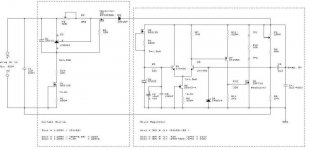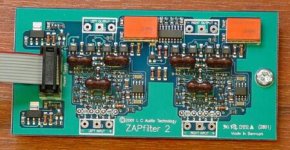Got a couple of sick vintage Japanese amps in to work on, and after fixing the glaring problems, saw that both had excessive DC offset (>150mV). At the time, I didn't have any real decent Japanese transistors to replace them with, so I thought I'd just stick in a couple of Zetex ZTX1056A's on one that needed NPN's, and a pair of ZTX795A's on the one that needed PNP's. Offset dropped to below 15mV on all channels.
I had intended to replace the Zetex transistors with 2SA872A's and 2SC1775A's as soon as I got them in. However, after listening to the amps as they are, they sound absolutely wonderful!! For the life of me I can't see any reason to put in the Japanese transistors when they arrive.
For the hell-of-it, I opened up an old Kenwood mid-powered amp that had 2SA872's in the input stage, and replaced them with the ZTX795A's. I can't believe the difference!! Totally opened up the soundstage, and brought a depth to the music that I haven't heard in a long time.
I honestly haven't had much experiance with Zetex transistors. I thought these were really (sorta...) intended for use in high-current switching applications (1/2A to a couple of amps). The ft and output capacitance of these devices are nothing to brag about, so why the crystal clear sound?
I'm leaving these amps as they are, and saving the Japanese transistors for another day.
Anyone else have much experiance with Zetex devices? Noticed anything close to what I experianced? Or am I hallucinating? 😕
I had intended to replace the Zetex transistors with 2SA872A's and 2SC1775A's as soon as I got them in. However, after listening to the amps as they are, they sound absolutely wonderful!! For the life of me I can't see any reason to put in the Japanese transistors when they arrive.
For the hell-of-it, I opened up an old Kenwood mid-powered amp that had 2SA872's in the input stage, and replaced them with the ZTX795A's. I can't believe the difference!! Totally opened up the soundstage, and brought a depth to the music that I haven't heard in a long time.
I honestly haven't had much experiance with Zetex transistors. I thought these were really (sorta...) intended for use in high-current switching applications (1/2A to a couple of amps). The ft and output capacitance of these devices are nothing to brag about, so why the crystal clear sound?
I'm leaving these amps as they are, and saving the Japanese transistors for another day.
Anyone else have much experiance with Zetex devices? Noticed anything close to what I experianced? Or am I hallucinating? 😕
Zetex...
Hi,
I really like the zetex transistors. I've been using them for several years now, and have been very happy with them.
Now, that being said, they do need a good burn in. I've noticed that for some transistors, their DC gain can change. Check their beta right off the bat, then run them at a high relative power level for a while, and check them again. I've noticed that the gain will drop to approximatley 50%, for some transistors. The transistors that I use for diff pairs, I run at almost full power for a few days, then match them.
Other than that, I really like them a lot. In fact, I've used mostly Zetex transistors for my designs. Partially, because of their high voltage ratings, and partically because I can get them easily here in the US.
They also make MOSFETs that I've been thinking of trying. Internally isolated from the package, so no need for a mica wafer or sill pad when mounting them...
So, can you describe the sound, how it was differrent? I'm just curious. I've noticed they seem to be very very clean, there's not really any other way to put it.
-Dan
Hi,
I really like the zetex transistors. I've been using them for several years now, and have been very happy with them.
Now, that being said, they do need a good burn in. I've noticed that for some transistors, their DC gain can change. Check their beta right off the bat, then run them at a high relative power level for a while, and check them again. I've noticed that the gain will drop to approximatley 50%, for some transistors. The transistors that I use for diff pairs, I run at almost full power for a few days, then match them.
Other than that, I really like them a lot. In fact, I've used mostly Zetex transistors for my designs. Partially, because of their high voltage ratings, and partically because I can get them easily here in the US.
They also make MOSFETs that I've been thinking of trying. Internally isolated from the package, so no need for a mica wafer or sill pad when mounting them...
So, can you describe the sound, how it was differrent? I'm just curious. I've noticed they seem to be very very clean, there's not really any other way to put it.
-Dan
Zetex
The White audio labs amps used Zetex BJT transistors for the front end with a IR mosfet output stage and sounded very nice. I will try to dig up the part numbers later. I believe Nelson Pass also uses some of the BJTs and mosfets for some of his designs. I like the mosfets for current sources, upper transistors in cascodes, and as followers. They are easily available from Digi Key and the website has good Spice models for most of the devices that I have looked at or designed in. I just received some 1 watt SMTs with an Ft of 165 MHz and an Hfe of about 400 from 10mA to 1 A. Another designer on the forum got pretty excited by the data on this one as well. Several the devices seem to fit into region between small signal and small power transistors. Here is a regulator I found that uses the Zetex BJTs. I think the End Millennium XP Amplifier might use them as well.
http://www.soundlabsgroup.com.au/lc..._millennium.htm
The White audio labs amps used Zetex BJT transistors for the front end with a IR mosfet output stage and sounded very nice. I will try to dig up the part numbers later. I believe Nelson Pass also uses some of the BJTs and mosfets for some of his designs. I like the mosfets for current sources, upper transistors in cascodes, and as followers. They are easily available from Digi Key and the website has good Spice models for most of the devices that I have looked at or designed in. I just received some 1 watt SMTs with an Ft of 165 MHz and an Hfe of about 400 from 10mA to 1 A. Another designer on the forum got pretty excited by the data on this one as well. Several the devices seem to fit into region between small signal and small power transistors. Here is a regulator I found that uses the Zetex BJTs. I think the End Millennium XP Amplifier might use them as well.
http://www.soundlabsgroup.com.au/lc..._millennium.htm
Attachments
dkemppai,
I'm really poor at describing what I hear, but perhaps 'clean', 'natural', 'unstressed'....maybe that's a start. I'm simply floored by the difference.
Fred,
Guess I haven't paid as much attention to actual components as I have to general topology. And I've never heard anyone even mention the use of Zetex transistors, so I was suprised by my findings. Makes me happy to see that they are well regarded...
...but damn these things are tiny!! Hard to believe that some of the bipolars can handle 3A, and most can disappate 1W!
I'm really poor at describing what I hear, but perhaps 'clean', 'natural', 'unstressed'....maybe that's a start. I'm simply floored by the difference.
Fred,
Guess I haven't paid as much attention to actual components as I have to general topology. And I've never heard anyone even mention the use of Zetex transistors, so I was suprised by my findings. Makes me happy to see that they are well regarded...
...but damn these things are tiny!! Hard to believe that some of the bipolars can handle 3A, and most can disappate 1W!
MAT Differential Pairs
In the recent past i have used MAT02/03 (Analog Devices) diffential pairs for the input stage. They exibit good features except for the Vce. (40V) These transistors are closely matched and have a good long term stability. I found out that these pairs sound excellent in comparison with other pairs i have used.
I have also seen Zetex components in other commercially audio equipment for instance the Quad amplifier. In most cases the sound of this equipment is pretty nice.
Regards
Piersma
In the recent past i have used MAT02/03 (Analog Devices) diffential pairs for the input stage. They exibit good features except for the Vce. (40V) These transistors are closely matched and have a good long term stability. I found out that these pairs sound excellent in comparison with other pairs i have used.
I have also seen Zetex components in other commercially audio equipment for instance the Quad amplifier. In most cases the sound of this equipment is pretty nice.
Regards
Piersma
Saw your other post. 😉 You know you can delete posts up to a time.... (I've messed up and created a new post accidently lots of times).
Never heard of Zetex transistors in a commercial product. Got a link??
..anyway, thanks for the input you all. Just wanted to see if I was crazy or not. Looks like I'm not the only one who thinks the Zetex trannies do a good job.
Never heard of Zetex transistors in a commercial product. Got a link??
..anyway, thanks for the input you all. Just wanted to see if I was crazy or not. Looks like I'm not the only one who thinks the Zetex trannies do a good job.
more zetex
Another couple Zetex users
http://www.altavistaaudio.com/solid1.html
http://www.soundlabsgroup.com.au/lcaudio/lc_audio_zapfilter_mk2.htm
Another couple Zetex users
http://www.altavistaaudio.com/solid1.html
http://www.soundlabsgroup.com.au/lcaudio/lc_audio_zapfilter_mk2.htm
Attachments
- Status
- Not open for further replies.
- Home
- Amplifiers
- Solid State
- Input Differential Pairs and Zetex Transistors

